 |
 |
|
 |
Lt. Gov. Molnau seeks legislative support for financing package |
 |
 |
Lt. Gov. Carol Molnau promoted the need for increased transportation funding
by seeking legislative support for the administration’s financing package at
a House Transportation Finance Committee hearing April 2.
Molnau described how the package would accelerate $1-1.2 billion worth of long-delayed
construction projects by as much as nine years. She outlined the plan’s innovative
financing approach that calls for issuing $550 million of new state trunk highway
bonds which will leverage a like amount of future federal funds.
"I believe the plan will be successful in its goals to provide congestion
relief, add system capacity and enhance economic and personal mobility in Greater
Minnesota and the Twin Cities metro area," said Molnau. "I also want
to stress that to make this plan a success the Minnesota Department of Transportation
will refocus on its core responsibilities of roadway safety, preservation and
project construction."
Molnau told the committee that the financing package was not the "end-all"
to transportation financing and a longer-term plan is needed.
"This plan will get us through these tough economic times," she said.
"In a deficit year, this is a good plan. However, we will continue to look
at new, creative ways to fund long-term transportation needs. We are looking
at ways for those who use the road to pay for the road."
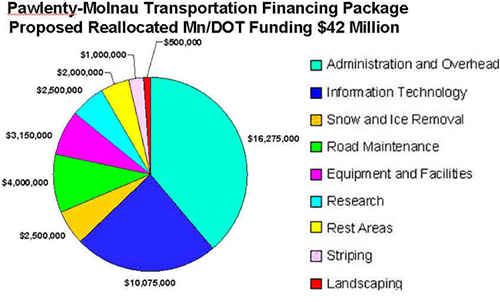 |
Redirecting $42 million in Mn/DOT spending from lesser-priority initiatives
to highway construction projects will pay the debt service on $550 million
in new trunk highway bonds.
|
When questioned about the $42 million Mn/DOT plans to use to pay the debt service
for the bonding in the plan, Molnau emphasized that the bulk of the redirected
funds will come from administration and overhead expenses.
She further emphasized the areas that have gotten the most attention--rest
areas, snow and ice removal and striping—will be evaluated to provide the most
cost-effective service to citizens without compromising safety.
Molnau also has written a guest commentary about the financing package that
has appeared in several Minnesota newspapers. Follow http://www.dot.state.mn.us/financing/
to read the commentary and get further background on the Pawlenty/Molnau Transportation
Financing Package.
Next week, Molnau is scheduled to present the package at the Senate’s Transportation
Policy and Budget Committee.
A copy of Lt. Gov. Molnau’s legislative presentation is available at: http://www.dot.state.mn.us/financing/documents/aprilpresentation.ppt
By Lucy Kender
|
back

|
 |
Kick-off set for the largest one-year construction program
|
 |
 |
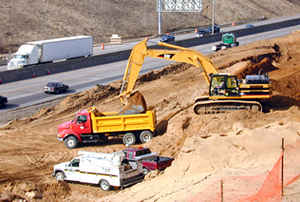 |
The I-494/Hwy 61 Wakota Bridge
replacement project, which crosses the Mississippi River, includes local
road improvements in St. Paul, South St. Paul, Newport, and St. Paul
Park. Photo by David Gonzalez
|
Mn/DOT will again mobilize its resources to improve the state’s highway system
as it officially begins the 2003 construction program on April 8. The department
will start or carry over nearly 200 projects designed to relieve congestion,
improve interregional corridors and enhance safety on the state’s 12,000-mile
trunk highway system.
The 2003 program totals 199 projects—137 in Greater Minnesota and 62 in the
Twin Cities metro area. Of that total, there are 79 projects carried over and
120 new ones.
Although muddy conditions caused by this year’s deep freeze and quick thaw
may delay the start of a few projects, they are not expected to affect project
completion dates.
New contract lettings this year represent a drop compared with 2002 because
of the one-time funding the department received in 2000 with a mandate that
the projects be completed by June 2003. Mn/DOT is on track to use the full allocation
it received in 2000. Future project funding depends on action by the Legislature
during its current session.
This year’s program includes rebuilding corridors such as Hwy 52 in Rochester
and Hwy 23 between Willmar and New London, the new Main Avenue Bridge (Hwy 10)
that will connect Moorhead and Fargo and the Piedmont Avenue (Hwy 53) reconstruction
project in Duluth.
Brainerd/District 3 will continue expanding Hwy 371 to four lanes on the section
between the new, four-lane Brainerd 371 bypass and Camp Ripley while Mankato/District
7 will continue its work on Hwy 60, expanding the highway from two to four lanes
between Heron Lake and Wilder.
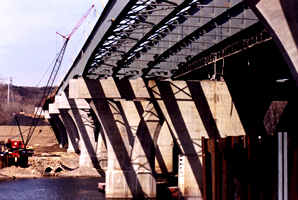 |
Work continues for the second year on the I-35E Lexington Bridge across
the Mississippi River in St. Paul. The project is scheduled for completion
in fall, 2004. Photo by David Gonzalez
|
Bemidji/District 2 will undertake projects such as resurfacing Hwy 2 between
Marcoux Corner and Erskine and a new bridge on Hwy 197 (Midway Drive) this season.
Continuing projects also include widening Hwy 23 between Cold Spring to Richmond
in District 3 and rebuilding Hwy 14 to four lanes between Eagle Lake and Janesville.
Twin Cities metro area projects include expanding I-494 from four to six lanes
between Hwy 5 to France Avenue and completion of the new Wakota Bridge that
will carry I-494 over the Mississippi River between Newport and South St. Paul
and eliminate a major traffic bottleneck. Work will also continue on the six-lane
expansion of I-94/I-694 from the I-494 junction east to Hwy 252.
"The one-time funding allocated by the Legislature has boosted spending
on transportation to record levels for now," said Lt. Gov./Commissioner
Carol Molnau. "But this one-time money expires on June 30; without additional
financing, the construction program next year will be reduced by 40 to 50 percent."
Last month, Gov. Tim Pawlenty and Molnau unveiled a transportation funding
package that would reduce the backlog of critical highway projects. The plan
would provide as much as $1.2 billion for ongoing highway construction during
the next five to six years.
"The 2003 program represents significant progress in our mission to reduce
congestion and improve safety and mobility across the state," said Bob
Winter, District Operations Division director.
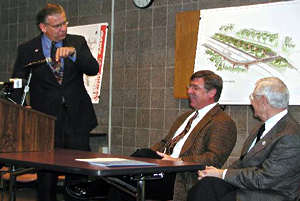 |
Groundbreaking ceremonies for the four-lane Piedmont
Avenue project in Duluth brought out dignitaries such as (left to
right) Duluth Mayor Gary Doty, Duluth/District 1 District Engineer Mike
Robinson and Mn/DOT Deputy Commissioner Doug Differt. Photo by Maureen
Talarico
|
"This month we will break ground on rebuilding Hwy 52 in Rochester. Using
the design-build method for the ROC 52 project instead of the traditional design-bid-build
method provides a good example of how Mn/DOT uses innovative ways to deliver
projects faster and more efficiently," he said.
Using design-build to expand an 11-mile section of Hwy 52 from four to six
lanes, he said, will enable Mn/DOT to cut five years from the standard time
needed to complete such a project.
"That’s five years of improved travel time for drivers, five years of
less disruption for businesses and residents and five years of improved safety,"
he said.
Winter also cited rebuilding Hwy 23 between Willmar and New London as a project
that will add significant capacity to one of Minnesota’s interregional corridors.
The project will expand 11 miles of the highway from two to four lanes.
Interregional corridors represent only two percent of all roadway miles in
the state, he said, but account for about one-third of all vehicle miles traveled.
"It’s crucial that we improve these roads now, because traffic volumes
have risen by 50 percent during the last 10 years and are expected to double
by the year 2020," Winter said.
By Craig Wilkins
|
back

|
 |
Mankato District takes work zone safety message home to employees |
 |
 |
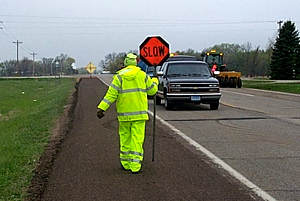 |
A flagger signals to warn motorists they are approaching a highway
work zone. Construction Office photo
|
Talking on his cell phone and leaning over the steering wheel to light a cigarette,
the driver of a van failed to notice a Mn/DOT flagger holding a sign in the
"Stop" position on a two-lane highway in Mankato/District 7.
The flagger jumped out of the van’s path and fell backward into a ditch. The
flagger at the other end of the project alertly stopped traffic about to move
into the work zone to prevent a head-on crash with the van.
The flaggers were wearing reflective vests and high-visibility hats and pants.
The signs and amber flashing lights were in place. The crew, said Dale Plemmons,
Mankato/District 7 safety administrator, had done everything by the book.
The problem, he said, was a distracted driver. This scenario, he said, is not
uncommon. Near-misses such as this may occur several times each year.
In a note to district employees, Plemmons made the following plea: "Please
be careful in work zones; distracted drivers are everywhere. We stand just inches
away from passing traffic. Remind the drivers you know about work zones and
how to limit their distractions while driving through work zones—encourage them
to disconnect cell phones, turn down the radio and limit unnecessary conversations.
Their safety and ours depends on attentive drivers."
The district is taking other steps to increase safety awareness as well.
Plemmons said the district will show the new video, "Mn/DOT Flagging Operations,"
produced by the Office of Communications, to its employees as part of its "toolbox"
training program. (Copies of the video may be ordered from Leigh Kriewall, 651/296-6223,
or by e-mail.)
Other district activities include a poster contest for children of district
employees to illustrate the need for safety in work zones. The posters will
be displayed, he said, to emphasize each family’s stake in the safety of all
district employees.
The district’s efforts will receive support from Mn/DOT’s statewide work zone
safety campaign and the observance of Workers Memorial Day in Mankato on April
28.
Plemmons said, however, that employees must start where they can—with co-workers,
friends and family to stress the need for more attentive driving in the state’s
highway work zones.
"We have to get our friends and families thinking about better safety
out there between the cones and barrels," he said.
By Craig Wilkins
More projects require extra patience, care by motorists
This season’s 182 projects mean drivers will need to exercise their
best judgment, care and patience when they encounter highway projects
this year. To emphasize that need, Mn/DOT will begin its summer work
zone safety campaign, "See orange. Slow down in work zones,"
during National Work Zone Awareness Week (April 6-12).
The campaign is part of a national campaign to reduce the number of
crashes, injuries and fatalities in all highway work zones, said Mary
Meinert, work zone safety coordinator, Communications.
|
|
back

|
 |
Cooperative efforts move Hwy 12 bypass closer to groundbreaking |
 |
 |
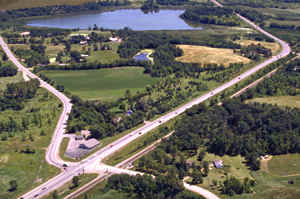 |
This aerial view of Long Lake shows the existing alignment of Hwy 12.
|
The long-planned reconstruction of Hwy 12 in Long Lake and Orono moved substantially
closer to reality with approval of Mn/DOT’s construction plans by the Minnehaha
Creek Watershed District.
The Metro District plans to rebuild five miles of the highway in Hennepin County
just west of Minneapolis starting in this summer. The project area has experienced
extensive growth in population, commercial development and commuter travel.
Hwy 12’s current location prevents it from performing adequately as Long Lake’s
main street or as a part of a regional corridor, said Gayle Gedstad, project
engineer, Metro District.
The highway will be realigned along the Burlington Northern/Santa Fe Railroad
right of way it currently parallels. The project will require moving about four
miles of the existing track to build the new Hwy 12 alignment. Its design will
be an access-controlled, "super two" style roadway. (A "super
two" roadway has wider lanes and shoulders, better sight lines and includes
safer opportunities for passing than a standard two-lane highway design.)
The new alignment will allow Long Lake to reclaim its downtown area along Hwy
12 by directing through traffic, especially large trucks, to the bypass. "Old
Hwy 12" will become a county road serving local and downtown area traffic.
Bypassing downtown Long Lake will reduce traffic congestion substantially,
Gedstad said. Without the bypass, traffic counts would eventually increase from
22,000 average daily traffic to 45,000 ADT.
The project’s first phase will extend from Wayzata Boulevard in Wayzata to
Hennepin County Road 6 in Orono. Cost for the first stage of construction is
about $40 million.
Completion of the project’s first phase is planned for fall 2006. The second
phase, which includes new interchanges with Hwy 12 at Wayzata Boulevard and
Hennepin County Road 6, will start in 2005 and be finished by fall 2006.
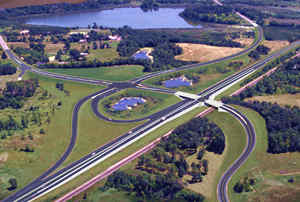 |
This computer simulation shows the future alignment of Hwy 12. The
highway will be south of the existing alignment and parallel to the
Burlington Northern/Santa Fe railroad tracks.
|
Protecting the environment
Protecting water quality in the project area for Long Lake, Classen Lake and
streams such as Long Lake Creek has been a crucial issue. Solutions have been
reached by officials from the watershed district, the cities of Orono, Wayzata
and Long Lake, the Department of Natural Resources, the Pollution Control Agency
and Mn/DOT.
Erick Evenson, watershed district manager, said cooperative efforts by each
agency involved in the project was instrumental to reach agreements on plans
to protect water quality and other environmental concerns during construction
and when the project is completed.
An arrangement by Mn/DOT and Orono, for example, enables Mn/DOT to replace
about 13 acres of wetlands taken for the project with 24 acres of new wetlands
that will be created in the city’s parks and other open spaces.
The project also required that Mn/DOT purchase all or parts of 142 parcels
of property, including the Long Lake city hall and its fire station.
The project will also include drainage ponds, slopes covered with vegetation
to absorb runoff and other methods to limit the amount of dissolved solids,
phosphates and other pollutants entering lakes and streams.
Replacing wetlands in the immediate area is important, Evenson said, because
it helps retain the project area’s environmental balance and its ability to
support birds and other wildlife.
When completed, the rebuilt roadway will relieve congestion in the busy corridor
and improve safety without creating detrimental effects to the area’s extensive
water resources.
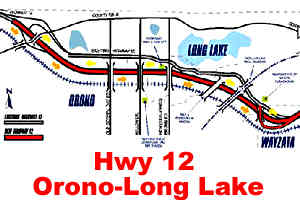 |
The proposed alignment of Hwy 12 will bypass downtown Long Lake and
should reduce traffic congestion substantially.
|
Considering esthetics
Plans for rebuilding Hwy 12 also call for other environmental and esthetic
considerations. Mn/DOT will move the historic truss-style bridge that carries
the Luce Line Trail over existing Hwy 12 to a nearby location where it will
span old Hwy 12. Wooden noise walls will provide a buffer between the new highway
and St. George’s Cemetery in Long Lake. Retaining walls will be built in varying
levels so that vegetation such as shrubs can be planted in front of them to
soften their visual impact.
"This project has been envisioned for more than 40 years," Gedstad
said. "We want to make sure we do it right."
By Craig Wilkins
|
back

|
 |
New on the Web: Links to layoff resources, updates, timeline |
 |
 |
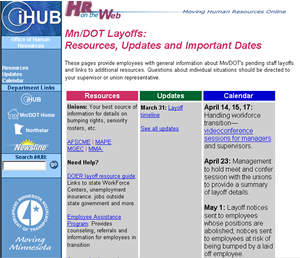 |
The Office of Human Resources has added layoff information to its Web
site.
|
The Office of Human Resources has set up a new Web site to provide employees
with general information about Mn/DOT's pending staff layoffs and links to additional
resources.
What you’ll find on the site are:
-
Resources, such as links to the state employee assistance program,
a layoff resource guide from the Department of Employee Relations, guidelines
for managers and supervisors to improve employee communications, and unions’
Web sites
-
Updates on the layoff process
-
Calendar of significant dates of the layoff process
For more information about the site, click on http://ihub/layoffguide.
Questions about individual situations should be directed to your supervisor
or union representative.
Workforce transition sessions offered for managers, supervisors
Information sessions for managers and supervisors to handle workforce transitions
will be offered in mid-April to most department locations via videoconference.
A state Employee Assistance Program representative will lead the sessions,
which will be offered by videoconference April 14 (10:30-12:30) and April 17
(8:30-10:30) to all districts A and B sites and in Central Office. A third session
will be offered April 15 (11:00-1:00) in Central Office Room G22.
Registration is necessary because of space limitations and so materials can
be delivered to participants in advance. Click here for
more information about registration and the topics to be covered.
|
back

|
 |
Speech! Speech! Text from recent commissioner speaking engagements available on
iHUB |
 |
 |
You may not have attended the recent Intelligent Transportation System Minnesota
annual meeting or the James L. Oberstar Forum on Transportation Policy and Technology—both
of which featured Lt. Gov./Commissioner Carol Molnau as a speaker—but you can
now read what she had to say on Mn/DOT’s iHUB site.
Click here to view a list of recent
speeches the lieutenant governor and Deputy Commissioner Doug Differt gave
or visit the Commissioner’s
Web page, which provides links to additional information about topics of
interest to Mn/DOT employees.
|
back

|
 |
|
 |



